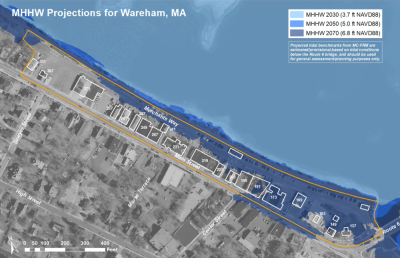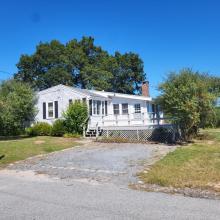Redevelopment Authority looks for ways to stay afloat
Consultants had a stark ultimatum for those who are making plans to revitalize downtown Wareham: Adapt or drown.
Speaking to the Redevelopment Authority on Thursday, Feb. 9, representatives of Fuss & O’Neill and the Woods Hole Group presented studies showing the average high tide rising 3.7 feet higher than today in 2030, 5 feet higher in 2050 and 6.8 feet higher in 2070.
Massachusetts sea level rise projections suggest that Mean Higher High Water (the average of the higher of the daily high tides) in this area would not cause flooding along Merchants Way or lower portions of Main Street until 2070. However, as sea levels rise and coastal storms become more frequent and intense, this already low-lying corridor will become increasingly vulnerable to storm surge impact.
The challenge, officials agreed, is how to revitalize downtown Wareham while preventing its destruction.
“That’s the inherent tension we’re going to have to start unpacking,” said Eileen Gunn, a project manager at Fuss & O’Neill. “What are your visions for the future, and how can we build a resiliency plan that matches with your urban redevelopment efforts? How can we marry the two?”
As soon as 2050, there is a greater than 1% chance of storm surge flooding all of Merchants Way and Main Street. As soon as 2070, that could increase to a 10% chance annually.
Fuss & O’Neill Senior Water Resources Engineer Dean Audet compared the risk of flooding to rolling a 100-sided die.
“It’s not impossible to roll three ones in a row, but it happens,” he said. “And every year, that risk increases.”
Prior to Saturday’s meeting, Fuss & O’Neill and Woods Hole released three videos updating residents about their findings. A large portion of eastern Main Street, from 219 to 137, is made up of buildings “not practical to floodproof” due to their age and elevation.
“We consider those buildings a lost cause,” said Director of Planning and Community Development Ken Buckland.
The town is considering buying those buildings and demolishing them to create “green space” and construct modern buildings which would be easier to floodproof. When these green spaces are not absorbing floodwaters, they can be used for recreation.
Even buildings currently marked as “safe” will become harder to floodproof as sea levels rise and storms produce higher water levels.
The studies also found that the central part of Merchants Way, from the fire station to TD Bank, has severely limited space for anti-flood construction.
“To be blunt, watching this, we’re screwed,” Town Administrator Derek Sullivan said. “Are we just missing where there’s a major choke point over there?”
Sullivan asked if the floodwaters could somehow be “funneled” away from buildings on Main Street.
“Mother Nature doesn’t quit,” said Select Board Chair Judith Whiteside. “So your comment about funneling it… you can’t.”
Audet said that rather than being “screwed,” the flood risk provides an opportunity to “reimagine” Wareham.
The Redevelopment Authority’s proposal to increase building height to 65 feet in downtown Wareham, and allow mixed-used zoning to increase population density, could be the key to protecting against flooding. Buildings would be elevated with parking lots on ground level.
To that end, the Redevelopment Authority is placing an article to amend the zoning bylaws on the agenda of this spring’s Town Meeting.
Officials mentioned a variety of other solutions, such as elevating buildings on stilts or a mound of earth, creating a berm or sea wall along the Wareham River and installing floodproofing measures. These measures include covering walls with sealing, bricking up abandoned doors and windows and installing flood shields in front of doorways.
There was even a suggestion to move Main Street’s commercial activity to High Street, a controversial idea because it would compromise the street’s historic homes and scenic views.
Select Board member Ron Besse warned against Wareham “becoming Las Vegas,” where tall buildings prevent residents from enjoying scenic views.
He also wondered whether the dangers to Main Street will scare businesses from the town.
“I can’t tell you that right now,” Audet said, “but hopefully I can tell you that in five months… You’re buying insurance. This is risk reduction.”
Sullivan was wary of “abandoning business” in a commercially viable area like Main Street.
“We’re a waterfront community that’s economically like a western Massachusetts community,” Sullivan said. “Not every waterfront town is rich… I understand that this is aspirational, we’re looking 50 years into the future and such, but what is the goal we’re trying to look at here?”
The MBTA train tracks along Merchants Way are another complication. Since they are state property, the town has no jurisdiction over them.
“They’re not going to let their engines plow through four feet of water,” Whiteside said. “At some point, they’re going to have to elevate — not happening — or move.”
“What’s interesting is that the high tide won’t reach the railroad tracks until 2070,” Buckland said, “which means there’s time to invest in those properties [near the tracks].”
The Redevelopment Authority is currently working on a comprehensive plan to obtain funding for anti-flood projects. Gunn said that the time to act is now, due to an “unprecedented” influx of funding from the recent infrastructure bill which might not be around forever.
“In order to use those funds before anyone else does,” Whiteside said, “we have to be creating new zoning.”
Meeting attendees received a survey asking them what their priorities were for Main Street, and how willing they were to “retreat… vulnerable buildings to create floodable public green spaces” and “create edge adaptations” such as a berm or sea wall.
Residents can learn more about the project by visiting https://tinyurl.com/5n7jj6cb, and give feedback by taking a survey at https://tinyurl.com/ye2a3ubh.














